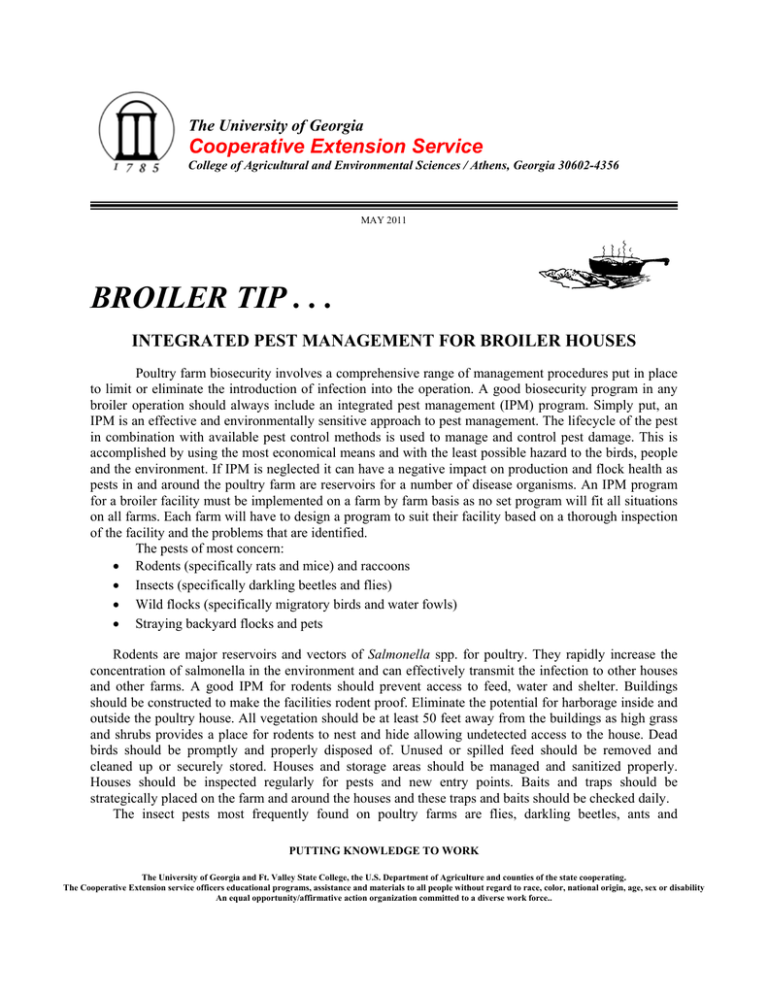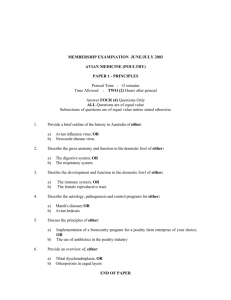BROILER TIP . . . Cooperative Extension Service The University of Georgia
advertisement

The University of Georgia Cooperative Extension Service College of Agricultural and Environmental Sciences / Athens, Georgia 30602-4356 MAY 2011 BROILER TIP . . . INTEGRATED PEST MANAGEMENT FOR BROILER HOUSES Poultry farm biosecurity involves a comprehensive range of management procedures put in place to limit or eliminate the introduction of infection into the operation. A good biosecurity program in any broiler operation should always include an integrated pest management (IPM) program. Simply put, an IPM is an effective and environmentally sensitive approach to pest management. The lifecycle of the pest in combination with available pest control methods is used to manage and control pest damage. This is accomplished by using the most economical means and with the least possible hazard to the birds, people and the environment. If IPM is neglected it can have a negative impact on production and flock health as pests in and around the poultry farm are reservoirs for a number of disease organisms. An IPM program for a broiler facility must be implemented on a farm by farm basis as no set program will fit all situations on all farms. Each farm will have to design a program to suit their facility based on a thorough inspection of the facility and the problems that are identified. The pests of most concern: Rodents (specifically rats and mice) and raccoons Insects (specifically darkling beetles and flies) Wild flocks (specifically migratory birds and water fowls) Straying backyard flocks and pets Rodents are major reservoirs and vectors of Salmonella spp. for poultry. They rapidly increase the concentration of salmonella in the environment and can effectively transmit the infection to other houses and other farms. A good IPM for rodents should prevent access to feed, water and shelter. Buildings should be constructed to make the facilities rodent proof. Eliminate the potential for harborage inside and outside the poultry house. All vegetation should be at least 50 feet away from the buildings as high grass and shrubs provides a place for rodents to nest and hide allowing undetected access to the house. Dead birds should be promptly and properly disposed of. Unused or spilled feed should be removed and cleaned up or securely stored. Houses and storage areas should be managed and sanitized properly. Houses should be inspected regularly for pests and new entry points. Baits and traps should be strategically placed on the farm and around the houses and these traps and baits should be checked daily. The insect pests most frequently found on poultry farms are flies, darkling beetles, ants and PUTTING KNOWLEDGE TO WORK The University of Georgia and Ft. Valley State College, the U.S. Department of Agriculture and counties of the state cooperating. The Cooperative Extension service officers educational programs, assistance and materials to all people without regard to race, color, national origin, age, sex or disability An equal opportunity/affirmative action organization committed to a diverse work force.. cockroaches. While ants and cockroaches are more easily controlled with insecticides, flies and darkling beetles are not as easily controlled and are the insect pests that broiler producers are most concerned about. Darkling beetles have been found to carry over five different serotypes of Salmonella which they can shed in their droppings for up to 28 days. They can also harbor fungi and viruses. Avian coccidiosis is caused by protozoans which do not survive well in poultry litter. However, they survive as oocysts which are ingested by the beetles which may then be ingested by the birds. While darkling beetles act as vectors that can transmit disease causing organisms to chickens, the most serious impact that these beetles can have on the broiler farm is the structural damage that they can cause to the houses. The migration of the beetle larvae into the insulation for pupation results in extensive damage. Application of insecticides to the structure, including the floor, after cleaning can assist in lowering the beetle survival. (See Broiler Tip: “Darkling Beetles in Broiler Houses”, May 2010 for other methods of darkling beetle control). Flies are not as much of a problem in broiler facilities as they are in breeder facilities. In the broiler houses some fly breeding may occur especially in areas of wet litter. Excessive numbers of flies can be an annoyance to workers and can result in negative neighbor relations as the flies migrate and disperse to nearby homes and businesses. Flies defecate and regurgitate regularly resulting in spotting on equipment, structure and also on light fixtures causing a reduction in illumination levels. For fly control, cultural, biological and chemical approaches have been used. For the broiler facility, cultural and chemical approaches are the most suitable methods. Cultural methods would include keeping the litter as dry as possible. Proper ventilation can help to accomplish this. The birds watering system should be monitored and maintained to minimize leaks. Wet litter should be removed to reduce breeding of flies in the house. Fly bait and other fly control chemicals can be selectively applied to the interior and upper portion of the poultry house where flies rest. It is important to note that house flies will develop resistance to insecticides very quickly; therefore the rotation of insecticides with differing chemical bases is advised. It is important to note that all warm and cold blooded animal species are potential carriers of Salmonella spp. and therefore can introduce them to poultry houses. Houses should be constructed to deny access to all animals and birds and also to prevent birds from perching on the houses. Strays from backyard flocks should not be encouraged on the farm. All spilt feed should be cleaned up at once. Pets such as dogs and cats should not be allowed access to the poultry house. Dead birds should be properly and promptly disposed of as delay may encourage scavengers. Cats have been used as a biological control for rodents but this should not be done. Cats kept from one flock to the next can serve as carriers of salmonellas and Pasteurella multicoda (causes fowl cholera). In order for a Biosecurity program to be successful, it must include a successful IPM program. In order for an IPM to succeed all individuals who are associated with the facility (including managers, flock supervisors, contract farmers, farm hands, vets etc.) must adhere to the program, it is a team effort. The program should be periodically reviewed and adjustments made where necessary. Claudia Dunkley Extension Poultry Extension County Coordinator/Agent “Your local County Extension Agent is a source of more information on this subject.”




